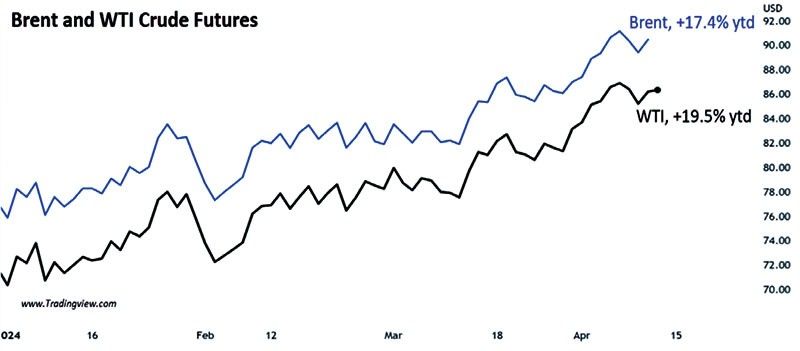$100 oil?

Oil prices surged to five-month highs due to rising tensions in the Middle East. The main trigger now is the possible war between Iran and Israel. These tensions have heightened concerns in the oil market causing a volatile environment.
The rush to hedge geopolitical risk propelled Brent futures to an intraday peak of $92.18 per barrel last Friday, eventually settling at $90.45 per barrel. Similarly, WTI futures peaked at $87.67 per barrel before settling at $85.66 per barrel. Year-to-date performance in Brent and WTI stands at 17.4 percent and 19.5 percent, respectively.

Source: Tradingview.com, Wealth Securities Research
Potential missile strikes on Israel
Iran has accused Israel of conducting a missile strike on its consulate in Damascus last April 1 that led to the deaths of a senior Iranian general and other Islamic Revolutionary Guard Corps (IRGC) commanders. This has raised concerns of massive retaliation in the form of possible strikes by Iran or its proxies on Israeli targets. This situation prompted Israel to close 28 embassies and consulates worldwide temporarily.
Risk of a regional conflict
The real risk is that this will turn into a broader regional conflict if Iranian-backed groups intensify their targeting of Israel and US forces in retaliation. Such a scenario could trigger heightened tensions across Syria, Lebanon, Iraq and possibly Jordan. Adding to these concerns is US President Biden’s promise of “ironclad” US support for Israel in the event of reprisal attacks which would lead to even more significant escalation.
Geopolitical tensions squeeze oil supply
A broader conflict in the Middle East may exacerbate supply challenges in the oil market which is already grappling with OPEC+ output cuts. Investors are wary of potential supply disruptions from critical producers like Iran and Iraq. The Middle East’s significant share of one-third of the global oil supply amplifies these concerns. Alongside these supply challenges, strong European demand and resilient economic activity in the US have also contributed to crude oil’s strong performance this year.
Ukrainian strikes and US sanctions on Russian oil
Another factor that is underpinning the price of oil is the Russia-Ukraine war. Analysts estimate that Ukrainian strikes targeting Russian oil-refining facilities have disrupted Russia’s refinery capacity by 10 percent to 14 percent. Additionally, stricter US sanctions have compounded these pressures. This has led to limited Russian fuel exports and excess Russian fuel floating at sea.
Investors bet on rising oil
Investors also increased their bets on rising oil prices to hedge against inflation risks. Recent data from the Commodity Futures Trading Commission (CFTC) reveals that investors have held the biggest net longs in WTI since mid-October.
JP Morgan forecasts $100 Brent
JP Morgan analysts see a scenario where Brent prices reach $100 per barrel by September. This projection is based on a reduction in Russian oil exports of 500,000 barrels per day by the end of June to align with OPEC+ commitments.
Goldman sees Brent staying below $100
In contrast, Goldman Sachs predicts oil prices staying below $100 per barrel. Their analysis assumes no further supply disruptions due to geopolitical tensions and increased production from OPEC+ due to the cartel’s high levels of spare capacity. Goldman believes that OPEC+ will be cautious in pushing oil prices to extreme highs. This stems from their experience in 2022 when Brent surged to near $140 per barrel but hurt the long-term demand for OPEC oil.
Fed rate-cut challenges
Rising oil prices present challenges for the Federal Reserve’s efforts to manage inflation as it affects the timing or magnitude of interest rate cuts. With the recent US inflation data surpassing expectations, the market expects a delayed Fed rate cut in September instead of June. Chicago Fed president Austan Goolsbee highlighted that the PCE is “re-inflating” and identified the Middle East as a wild card for the Fed. Meanwhile, Atlanta Fed president Raphael Bostic says he is “not in a hurry to cut interest rates” and anticipates a single rate cut toward the end of the year.
$100 oil, a scary possibility
Stocks sold off last Friday as geopolitical worries, inflation and the expectations of delayed Fed rate cuts finally dented investor sentiment. The S&P 500 suffered its worst day since January as it declined 1.46 percent, while the Dow and the Nasdaq tumbled 1.24 percent and 1.62 percent, respectively. Investors should closely monitor developments in the Middle East. If the Iran-Israel conflict escalates and involves the US & its Western allies then the possibility of a $100 oil becomes more likely.
Philequity Management is the fund manager of the leading mutual funds in the Philippines. Visit www.philequity.net to learn more about Philequity’s managed funds or to view previous articles. For inquiries or to send feedback, please call (02) 8250-8700 or email ask@philequity.net.
- Latest
- Trending
































